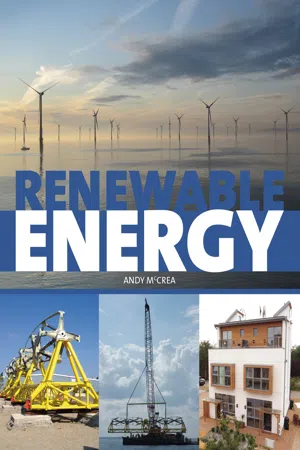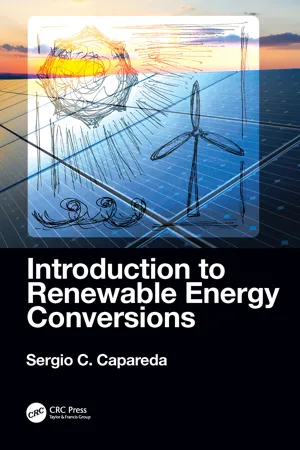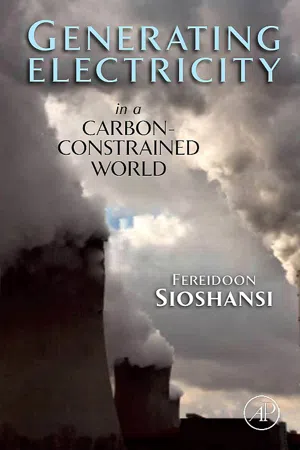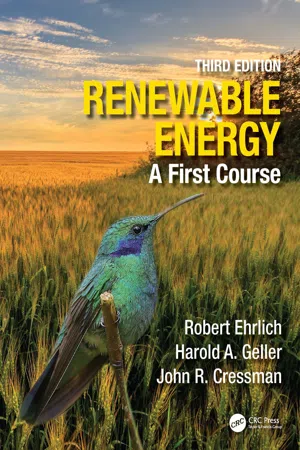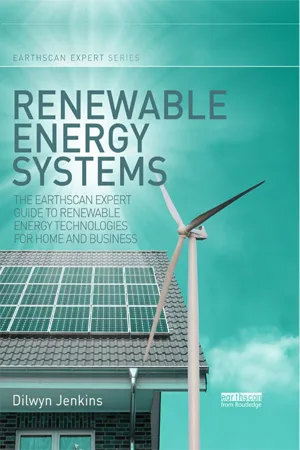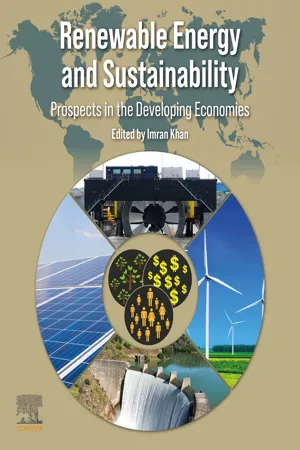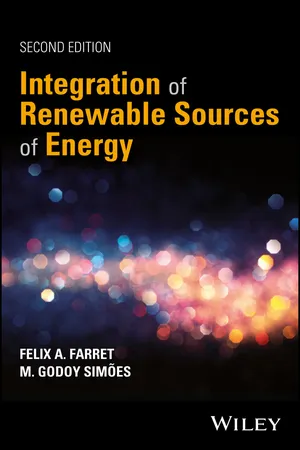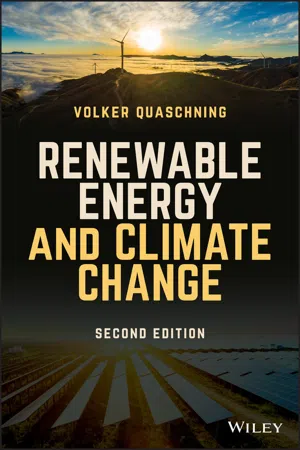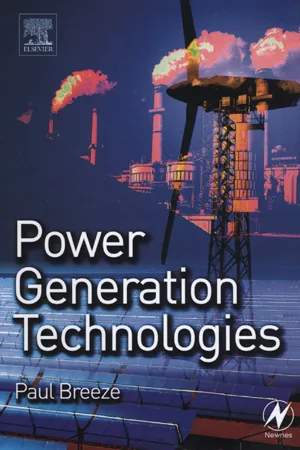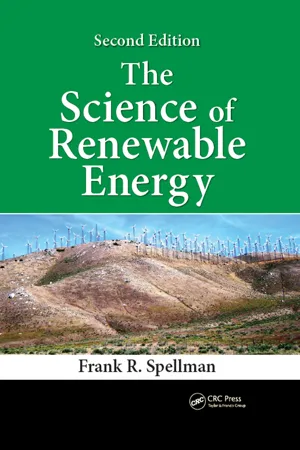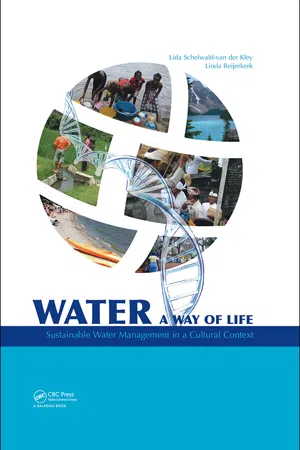Geography
Hydroelectric Power
Hydroelectric power is a form of renewable energy generated by harnessing the gravitational force of flowing or falling water. It involves the conversion of kinetic energy from water into electricity through turbines and generators. This method of power generation is considered environmentally friendly and sustainable, as it produces minimal greenhouse gas emissions and relies on the natural water cycle.
Written by Perlego with AI-assistance
Related key terms
12 Key excerpts on "Hydroelectric Power"
- eBook - ePub
Energy Policy Analysis: A Conceptual Framework
A Conceptual Framework
- Michael S Hamilton(Author)
- 2014(Publication Date)
- Routledge(Publisher)
8 Hydroelectricity Rainfall, like wind, is common but is unevenly distributed across the surface of the earth. Hydroelectric energy technologies, which in a sense use water for “fuel,” depend on rainfall to create flowing water that, when falling due to the gravitational pull of the earth, may be used to generate mechanical power to grind flour, motivate other machinery, or produce electricity. Thus, hydroelectric energy is produced by the force of falling water (USGS 2011). The movement of water as it flows downstream creates energy that can be converted into electricity. A Hydroelectric Power plant converts this energy into electricity by running water, often held in a reservoir behind a dam, through a hydraulic turbine connected to a generator. Water exits the turbine and is returned to a stream or riverbed below the reservoir (USEPA 2011). The capacity to produce hydroelectric energy is dependent on both the available flow and the height from which it falls. Building up behind a dam, water accumulates potential energy. The amount of power that may be extracted from water depends on the volume and the difference in height between the source and the turbine. This height difference is called head. The amount of potential energy in water is proportional to the head. Falling water is used to turn a turbine, as illustrated in Figure 8.1. The turbine’s rotation spins electromagnets that generate current in stationary coils of wire. Finally, the current is put through a transformer where voltage is increased for long-distance transmission over power lines (USGS 2011). Thus, hydropower is mostly dependent upon precipitation and elevation changes; high precipitation levels and large elevation changes are necessary to generate significant quantities of electricity - eBook - ePub
Renewable Energy
A User's Guide
- Andy McCrea(Author)
- 2013(Publication Date)
- Crowood(Publisher)
CHAPTER 7Hydroelectricity
If you are fortunate enough to live beside a river or a fast-flowing stream, a small-scale hydroelectricity installation may provide an opportunity to achieve significant savings on your electricity bill and reduce your carbon footprint for many years to come.ELECTRICITY FROM RIVERS AND STREAMS
Hydroelectricity is the most widely used of the renewable technologies, with almost one-fifth of the world’s electricity generated from water power. In some third-world countries, hydroelectricity provides around 30 per cent of their demand for electricity. The largest hydroelectricity generating plants are in countries with high mountains and fast-flowing rivers, such as Canada, United States and China. These large-scale schemes draw water from reservoirs restrained by dams, although it is also possible to generate electricity from the flow of water in rivers and streams. The Netherlands, for example, although a predominantly flat country, has around 40MW of hydroelectric generating stations. The largest hydroelectric station currently operating in the world is the Itaipu project, a 12,600MW joint scheme between Brazil and Paraguay. Water stored behind dams means that it is available for electricity generation at times of greatest need; however, it suffers the disadvantage that large areas of land, indeed sometimes several villages, are lost in the inundation and subsequent water storage. Pumped storage schemes have been developed to pump water into reservoirs at times when there may be a surplus of electricity available and then to release it to generate electricity when it has the greatest value.Small-scale hydroelectricity is much less environmentally intrusive, generating electricity from reasonably fast-flowing rivers and from small streams with high heads but low flow. These small-scale run of river schemes are the main subject of this chapter. Most of the hydroelectric sites in the United Kingdom and Ireland with a potential of generating one megawatt of electricity and above have already been developed, but there are still a significant number of locations capable of producing electricity in the range 100kW to 500kW. With modern developments in micro and pico (very small) hydro technology, an even larger number of smaller sites in the range 10kW to 50kW are now considered economically viable. - eBook - ePub
- Sergio Capareda(Author)
- 2019(Publication Date)
- CRC Press(Publisher)
5Hydro Power
Learning Objectives
Upon completion of this chapter, one should be able to:- Describe the hydrologic cycle.
- Enumerate the various ways of generating useful energy and power from water resources.
- Estimate available power from water bodies.
- Describe the various impellers used for many water conversion devices.
- Describe the various conversion efficiencies.
- Describe the hydraulic ram and its design.
- Relate the overall environmental and economic issues concerning hydro power systems.
5.1 Introduction
Humankind has harnessed power and energy from water bodies over centuries. This renewable energy resource has perhaps been exploited by man on the largest scale. The hydrologic cycle is one of the earth's fundamental processes—water from the ocean evaporates, turns into clouds, and is brought back to land in the form of rain. This cycle is depicted in Figure 5.1 . As the earth's temperature rises, snow melts from higher latitudes and creates runoff, feeding lakes and streams with fresh water. Some water percolates through the ground and is temporarily stored in those areas. As water drops from higher elevations, energy-related events occur owing to the kinetic energy of water and the drop in potential energy.Hydro power supplies about 16% of the world's electricity requirement from all sources (WEC, 2017). Hydro power is the leading renewable energy source for electrical power worldwide and was found to make up 71% of all renewable electricity. The installed capacity (WEC, 2017) by region is as follows and represents the values at the end of 2015. The English equivalent of GW is translated into Quad/yr. One Quad is equivalent to 1 × 1015 Btu or 1.055 EJ (1018 - Fereidoon Sioshansi(Author)
- 2009(Publication Date)
- Academic Press(Publisher)
Chapter 12. Hydroelectricity Future Potential and BarriersJoão Lizardo de Araujo
Centro de Pesquisas de Energia Elétrica – CEPELLuiz Pinguelli Rosa
Instituto Alberto Luiz Coimbra de Pós-Graduação e Pesquisa de Engenharia – COPPE-UFRJNeilton Fidelis da Silva
Instituto Federal de Educação, Ciência e Tecnologia do Rio Grande do Norte – IFERN, Instituto Virtual Internacional de Mudanças Globais – IVIG/COPPE-UFRJAbstractThere is considerable untapped hydroelectric potential around the world, especially in developing countries. Electricity generated from hydro resources is characterized by extremely low operating costs and essentially zero fuel costs, which do not escalate over time, as is the case with fossil-fueled resources. With negligible greenhouse gas emissions relative to fossil-fueled generation, Hydroelectric Power offers an attractive solution to address global climate change. However, a number of barriers, including ecological impact and front-loaded investment in developing transmission and reservoir infrastructure, must be overcome for the full potential of the resource to be realized.12.1. Introduction
Since the dawn of civilization, hydropower has been an important source of energy for mankind. The earliest known application of water power dates back to at least 3000 years ago. Romans used water to run their flour mills as early as 21 centuries ago, as did other ancient civilizations. The earliest mills featured a vertical wheel on a horizontal shaft, with gears to transmit the movement of passing or falling water to a vertical shaft. Such water wheels are the ancestors of today's modern hydroelectric turbines used to convert the potential energy of water stored in an elevated reservoir into kinetic energy—which turns a turbine to generate electricity.- eBook - ePub
Renewable Energy
A First Course
- Robert Ehrlich, Harold A. Geller, John R. Cressman(Authors)
- 2022(Publication Date)
- CRC Press(Publisher)
HydropowerDOI: 10.1201/9781003172673-8Contents
- 8.1 Introduction to Hydropower
- 8.2 Wave, Tidal, and Ocean Thermal Power Resources
- 8.3 Introduction to Tidal Power and the Cause of Tides
- 8.4 Ocean Thermal Energy Conversion
- 8.5 Social and Environmental Impacts of Hydropower
- 8.6 Summary
- Problems
- Reference
8.1 Introduction to Hydropower
Hydropower, in which the motion of water is harnessed to do useful work, is essentially a form of solar energy that drives the planet’s water cycle and accounts for the flow of rivers and ocean waves. Certainly hydro is one of the earliest forms of renewable energy to be harnessed by humans. Its origins go back to usage for irrigation with the development of agriculture that first arose in 6,000 BC in Mesopotamia (now Iraq)—the “cradle of civilization.” Hydropower has continued to play a significant role over the centuries, and it fueled another major advance in civilization, namely, the industrial revolution. Until steam power was invented and came into widespread use, it was hydro that powered the many useful mechanical devices and machines behind that revolution. A third major technological advance—the large-scale usage of electricity around the turn of the twentieth century—also saw hydropower play a major role. In 1920, e.g., 40% of the electricity in the United States was generated by hydropower—a figure that has now dropped to around 6.8% with the advent of greater reliance on other methods. However, hydropower now accounts for about 60% of electricity from all renewable energy sources in the world, and in six nations, including Norway and Paraguay, it accounts for over 95% of their electricity.Hydropower can usefully generate energy over a vast range of scales, ranging from the largest power plants of any type in the world—the Three Gorges Dam and 22,500 MW power station in China down (Figure 8.1 ) to the nanoscale hydropower plant of a mere 100 W—a factor of 20 million times smaller. Hydro is also an extremely versatile renewable energy source in terms of its wide variety of forms. The most important usage of hydro is the conventional or impoundment power plant hydro, where a dam is constructed to create a reservoir. When the water it contains is allowed to flow out in a controlled manner, it can be harnessed to create electricity. The basic components of a conventional Hydroelectric Power station are illustrated in Figure 8.2 - eBook - ePub
Renewable Energy Systems
The Earthscan Expert Guide to Renewable Energy Technologies for Home and Business
- Dilwyn Jenkins(Author)
- 2013(Publication Date)
- Routledge(Publisher)
In North America and Europe, preferential feed-in tariffs (FiTs) are increasingly available for clean electricity generation (see Annex 1 for more details). In combination with these tariffs, hydropower often becomes the most bankable of renewables. In some US states there are also rebates available which offset some of the capital costs. Hydropower will only work, however, if an appropriate water resource is available. Even with a good stream or river resource with plenty of drop, most countries have a series of often very tight regulations – implemented by National Water Authorities, Environment Agencies or Ministries – which can restrict a hydro project’s generating potential and increase the capital costs to such an extent that it becomes non-viable.Hydro presently provides more than 20 per cent of the world’s electricity requirements and, in 2010, accounted for 6 per cent of total US electricity generation and some 60 per cent of renewable generation. Given the source of hydropower – water – it’s not hard to understand why the term can encompass everything from mechanical water mills to ocean-based wave machines for generating grid electricity. In this chapter, however, we focus on the more established and traditional form of hydropower, which offers the potential to take energy out of streams and rivers as long as there is sufficient flow and drop (or ‘head’, see the Useful Hydro Terms section below). In particular, we focus on micro hydropower that can provide electricity in the range of 500 W to 5 kW. The same principles apply to larger micro and small hydro systems: it’s just all on a larger scale.Hydro Scales (as used in this book)The definitions of terms and scales for hydro vary considerably country by country, but generally speaking micro hydro is understood as the application of Hydroelectric Power sized for small communities, single families or small enterprise. The term ‘pico hydro’ is also commonly used to describe hydro schemes in the range up to about 5 kW, which relates to most of the schemes or designs referred to in this chapter. - eBook - ePub
Renewable Energy and Sustainability
Prospects in the Developing Economies
- Imran Khan(Author)
- 2022(Publication Date)
- Elsevier(Publisher)
Globally, hydropower is the largest source of renewable electricity (15.9%) out of a total of 27.3%, generating more electricity than all other renewables combined (11.4%). However, in the era of the energy transition with the aim of limiting the global temperature rise to no more than 2°C, the development of sustainable hydropower construction is needed to increase significantly. The International Energy Agency's (IEA) flagship Net Zero by 2050 report (IEA, 2021) suggests that about 2600 GW of hydropower capacity is required by 2050 for keeping global temperature rises below 1.5°C. The energy in today's context needs to be sustainable. Coal-based power generation is now getting the least priority and most of them after completing their life are being abandoned. Globally, a determination toward emission-free energy is placed and most of the developed, as well as developing countries have started working on this. The hydropower being the most important renewable energy has been around for over a century and aims to provide energy security by complementing wind and solar energy in sustainable energy storage (Kaunda, 2012). Hydropower constitutes nearly all of the total electricity generation in several developing countries (Mozambique, Tajikistan, Zambia, and Nepal) and developed countries such as Norway, Canada, and Switzerland. 5.2 Historical background of hydropower development Hydro energy has been used for irrigation and the operation of various end-use equipment, like watermills, textile machines, lumber, and weaving machines, in numerous nations since ancient times. The mechanical power of flowing water is an old natural resource used for services and productive applications. Over 2000 years ago, Greeks harnessed power from flowing water to use watermills to crush wheat into flour. In the 1700s, mechanical hydropower was used extensively for milling and pumping. There are a number of places in the world where such technology is still being utilized - eBook - ePub
- Felix A. Farret, M. Godoy Simoes(Authors)
- 2017(Publication Date)
- Wiley(Publisher)
3 Hydroelectric Power Plants3.1 Introduction
Hydropower technology enables a large production of electric power. In addition to large hydropower projects implemented by governments, there are many private investments. The majority of rural properties have water creeks and small water heads that can be used as primary energy water‐based resource. Such energy is commonly used for machine operation, generation of electricity, and water storage in elevated reservoirs. Small electric power plants can also be used with waterwheels or, depending on the flow or the available head, with turbines. The first known turbine generator set, with approximately 8 hp, driven from a gross water head of 10 m was constructed in 1882 in order to supply carbon‐filament light bulbs. The first known small Hydroelectric Power plant was built in Northern Ireland in 1883, consisting of two turbines of 52 hp (1 horsepower = 746 watts) to supply energy for an electric train.In the same year in Diamantina, Brazil, a hydroelectric energy system of 12 kW (two generators driven by waterwheels) for an elevation of 5 m was established. Ever since, the diversified evolution of the energy sector has been influencing all sectors of everyday life. From that time, a variety of Hydroelectric Power plants became a reality [1].Hydroelectric Power plants can be driven from a water stream or from an accumulation reservoir. Run‐of‐river hydroelectric plants (those without accumulation reservoirs) are built along a river or a stream, without lake formation, for the intake of water. Therefore, the river course is not altered, and its minimum flow will be the same or higher than that of the turbine output power. The excess water must be diverted, and in this case, the water volume is not totally used. Costs are lower than those for reservoirs, with less environmental impact. However, the plant is unable to store energy. On the other hand, there is no need for extensive hydrological studies, just simple measurements for estimating the availability of power [2–4]. - eBook - ePub
- Volker V. Quaschning(Author)
- 2019(Publication Date)
- Wiley(Publisher)
www.itaipu.gov.br .In Germany, hydropower is mainly used in the southern federal states, where the rivers have a significantly greater gradient than in the north. In the flat north there are only a few small installations.9.8 Outlook and Development Potential
Hydropower is the most developed method for power generation based on renewables. In the industrialized nations most of the potential has already been exploited. The potential for new large-scale plants now mainly exists in developing and emerging nations. In many industrialized countries there is also great potential for modernizing or upgrading barrages and dams. Classic run-of-river and storage hydropower plants could at best double the output of electricity generated worldwide. However, in the long term their share of energy production worldwide will decrease, because the demand for electricity will continue to rise.Certain types of hydropower plants, such as wave and ocean current plants, which are not yet in use, show some promising potential for the future. However, substantial cost reductions are still needed before these types of power plants can have any major impact on the market.The biggest advantage of hydroelectric energy is its relatively consistent output of power, compared to solar energy and wind power. This aspect makes it easier to plan a mix of different renewable energies. With the increase in renewable energy's contribution to electricity generation, storage, and pumped-storage power plants are also becoming important options due to their ability to offer consistency in electricity supply. - eBook - ePub
- Paul Breeze(Author)
- 2005(Publication Date)
- Newnes(Publisher)
8Hydropower
Publisher Summary
This chapter discusses hydropower, the hydropower resource, generators, dams, turbines, and the various related environmental issues. Hydropower is the oldest and probably the most underrated renewable energy resource in the world. Once a site for a hydropower scheme has been identified, there are normally two ways of exploiting it. The first way is to build a dam and create a reservoir behind it from which water is taken to drive hydraulic turbines in the project’s powerhouse. The second way, called a run-of-river scheme, works without a reservoir, though it will usually involve some sort of barrage. A run-of-river scheme takes water directly from the river to the powerhouse where the turbines are installed. The chapter explains three principle types of dam used for hydropower projects: concrete dams, arch dams, and embankment dams. A concrete dam is basically a massive concrete structure which, as a result of its weight, resists the pressure of water behind it. Care must be taken, however, to prevent water flowing around or beneath the dam. Concrete construction is normally employed where a high dam can be built across a narrow ravine. Most hydropower plants employ conventional generators with one generator for each turbine.Hydropower is the oldest and probably the most underrated renewable energy resource in the world. The earliest known reference is found in a Greek poem of 85 BC. At the end of 1999 hydropower provided 2650 TWh of electricity, 19% of total global output.1 Yet when renewable energy is discussed, hydropower barely earns a mention.Part of the reason for this lies in the disapprobation that large hydropower has attracted over the past 10–15 years. Concern for the environmental effects of large projects which destroy wildlife habitats, displace indigenous peoples and upset sensitive downstream ecologies coupled with often heavy handed and insensitive planning and approval procedures have resulted in the image of hydropower becoming extremely tarnished. - eBook - ePub
- Frank R. Spellman(Author)
- 2016(Publication Date)
- CRC Press(Publisher)
The most common type of Hydroelectric Power plant is the impoundment facility, which typically is a large hydropower system that uses a dam to store river water in a reservoir. This type of facility works best in mountainous or hilly terrains where high dams can be built and deep reservoirs can be maintained. Potential energy available in a reservoir depends on the mass of water contained in it, as well as on overall depth of the water. Water released from the reservoir flows through a turbine and makes it spin, which in turn activates a generator that produces electricity. The water may be released either to meet changing electricity needs or to maintain a constant reservoir level.DIVERSIONA diversion (sometimes called run-of-river) facility channels all or a portion of the flow of a river from its natural course through a canal or penstock, and the current is used to drive turbines. This approach may not require the use of a dam. This type of system is best suited for locations where a river drops considerably per unit of horizontal distance. The ideal location is near a natural waterfall or rapids. The chief advantage of a diversion system is the fact that, lacking a dam, it has far less impact on the environment than an impoundment facility (Gibilisco, 2007).PUMPED STORAGEWhen the demand for electricity is low, a pumped storage facility stores energy by pumping water from a lower reservoir to an upper reservoir. During periods of high electrical demand, the water is released back to the lower reservoir to generate electricity.To assist in understanding material presented in this chapter, the key components that make up hydro turbines and hydropower plants are defined in the following:KEY TERMS
DID YOU KNOW?The potential energy in a specific slug or parcel of water is expressed in newton-meters (N·m). The newton is the standard unit of force, equivalent to meters per second squared (1 m/s2 ). The potential energy is the product of the mass of the slug (kg), acceleration due to gravity (about 9.8 m/s2 - eBook - ePub
Water: A way of life
Sustainable water management in a cultural context
- A.J.M. (Lida) Schelwald-van der Kley, Linda Reijerkerk(Authors)
- 2009(Publication Date)
- CRC Press(Publisher)
In view of sustainable development it is important to assess the benefits and impacts of dam development on a river basin scale instead of on an individual project basis. The socio-economic and environmental aspects of upstream-downstream linkages should thereby be taken into account.4.3.6 More power needed
There are many hydropower projects yet to come. Driven by economic considerations and the worldwide increasing need to use renewable energy sources, many countries have plans in stock to build new dams for hydropower generation. China is particularly active in this market and provides its engineering skills to other countries in exchange for resources like oil, minerals, copper and zinc.79 These are needed to keep up with the rapid pace of economic development domestically. The African continent as a whole is desperate to gain access to electricity. There are now serious plans to build the world’s biggest and most powerful hydroelectric dam and power plant ever in the Democratic Republic of Congo.80 The Grand Inga project will be built on the Congo River alongside two existing hydroelectric plants and is expected to begin operating between 2020 and 2025. The plant in Congo could potentially generate twice the energy of China’s Three Gorges dam and could help the estimated 500 million Africans without access to electricity. To make it a success the important social issues around the Grand Inga project must be dealt with satisfactorily. These include providing the poorer communities living closest to the source with electricity and compensating them for any negative repercussions to their livelihoods.4.4 POLITICAL POWER
4.4.1 Crossing boundaries
Throughout the ages water has been used to exert political power and gain control over people and over entire regions. The Roman Empire thanked its expansion greatly to the ability to cross natural boundaries such as the Rhine River and the Danube by building bridges over them. Other engineering masterpieces at the time were the aqueducts – conduits on arches – that were built by the Roman rulers to channel water to the towns and cities. In ancient Rome’s heyday, eleven aqueducts over 550 km long brought 190 million litres of water per day into the city that was further transported to the houses, fountains and baths, using lead pipes.64
Index pages curate the most relevant extracts from our library of academic textbooks. They’ve been created using an in-house natural language model (NLM), each adding context and meaning to key research topics.

